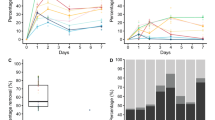Abstract
Zygomycetes such as Cunninghamella elegans seem to be promising biosorbents for pollutants removal from wastewaters because of their particular cell wall characteristics. In this article the effect of ten culture media on C. elegans biomass composition was investigated by means of Fourier transform infra red spectroscopy (FTIR). Biomasses grown on starches from potatoes and cereals were characterised by high amount of chitin and polysaccharides, the glucose gave rise to a biomass rich in acidic polysaccharides and lipids. By contrast, biomasses grown on corn steep liquor were poor in acidic polysaccharides and, when N sources and micronutrients were added, rich in proteins. The lipid content of the biomass generally increased by halving nutrients. Biosorption yields of these biomasses towards four wastewater models were assessed in terms of colour, salts and toxicity reduction. The biomasses rich in proteins and acid polysaccharides were less effective in removing reactive and direct dyes, whereas those rich in cationic polysaccharides showed a higher affinity for these dyes. Both chromatography and FTIR analyses showed that biomasses cultured in halved C and N had the highest affinity for salts. The wastewaters detoxification was quite always achieved, with values often lower that the Italian legal threshold limit.





Similar content being viewed by others
References
Bisschops I, Spaniers H (2003) Literature review on textile wastewater characterization. Environ Technol 24:1399–1411
Blackburn R (2004) Natural polysaccharides and their interactions with dye molecules: application in effluent treatment. Environ Sci Technol 38:4905–4909
Crini G, Badot P-M (2008) Application of chitosan, a natural aminopolysaccharide, for dye removal from aqueous solutions by adsorption processes using batch studies: a review of recent literature. Prog Polym Sci 33:399–447
Farkas V (2003) Structure and biosynthesis of fungal cell walls: methodological approaches. Folia Microbiol 48:469–478
Franco LD, Maia RDC, Porto ALF et al (2004) Heavy metal biosorption by chitin and chitosan isolated from Cunninghamella elegans (IFM 46109). Braz J Microbiol 35:243–247
Gadd MG (2009) Biosorption: critical review of scientific rationale, environmental importance and significance for pollution treatment. J Chem Technol Biot 84:13–28
Gochev VK, Velkova ZI, Stoytcheva MS (2010) Hexavelant chromium removal by waste mycelium of Aspergillus awamori. J Serb Chem Soc 75:551–564
Kona RP, Qureshi N, Pai JS (2001) Production of glucose oxidase using Aspergillus niger and corn steep liquor. Bioresource Technol 78:123–126
Parvathi K, Nagendran R (2008) Functional groups on waste beer yeast involved in chromium biosorption from electroplating effluent. World J Microbiol Biotechnol 24:2865–2870
Prigione V, Zerlottin M, Refosco D et al (2009) Chromium removal from a real tanning effluent by autochthonous and allochthonous fungi. Bioresource Technol 100:2770–2776
Russo ME, Di Natale F, Prigione V et al (2010) Adsorption of acid dyes on fungal biomass: equilibrium and kinetics characterisation. Chem Eng J 162:537–545
Sivasamy A, Sundarabal N (2011) Biosorption of an Azo dye by Aspergillus niger and Trichoderma sp. fungal biomasses. Curr Microbiol 62:351–357
Schroeder HW (1966) Effect of corn steep liquor on mycelial growth and aflatoxin production in Aspergillus parasiticus. Appl Environ Microb 14:381–385
Srinivasan A, Viraraghavan T (2010) Decolorization of dye wastewaters by biosorbents: a review. J Environ Manag 91:1915–1929
Stamford TCM, Stamford TLM, Stamford NP et al (2007) Growth of Cunninghamella elegans UCP 542 and production of chitin and chitosan using yam bean medium. Electron J Biotechn 10:61–68
Svecova L, Spanelova M, Kubal M et al (2006) Cadmium, lead and mercury biosorption on waste fungal biomass issued from fermentation industry. I. Equilibrium studies. Sep Purif Technol 52:142–153
Tekerlekopoulou AG, Tsiamis G, Dermou E et al (2010) The effect of carbon source on microbial community structure and Cr(VI) reduction rate. Biotechnol Bioeng 107:478–487
Tigini V, Giansanti P, Mangiavillano A et al (2010) Evaluation of toxicity, genotoxicity and environmental risk of simulated textile and tannery wastewaters with a battery of biotests. Ecotoxicol Environ Saf (in press)
Tigini V, Prigione V, Donelli I et al (2011) Cunninghamella elegans biomass optimisation for textile wastewater biosorption treatment: an analytical and ecotoxicological approach. Appl Microbiol Biotechnol 90:343–352
Zamani A, Edebo L, Sjöström B et al (2007) Extraction and precipitation of chitosan from cell wall of zygomycetes fungi by dilute sulfuric acid. Biomacromolecules 8:3786–3790
Zhang D, He HJ, Li W et al (2010) Biosorption of cadmium(II) and lead(II) from aqueous solutions by fruiting body waste of fungus Flammulina velutipes. Desalin Water Treat 20:160–167
Author information
Authors and Affiliations
Corresponding author
Rights and permissions
About this article
Cite this article
Tigini, V., Prigione, V., Donelli, I. et al. Influence of Culture Medium on Fungal Biomass Composition and Biosorption Effectiveness. Curr Microbiol 64, 50–59 (2012). https://doi.org/10.1007/s00284-011-0017-z
Received:
Accepted:
Published:
Issue Date:
DOI: https://doi.org/10.1007/s00284-011-0017-z




